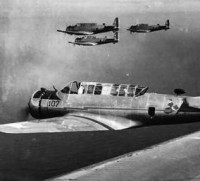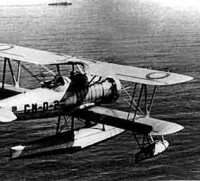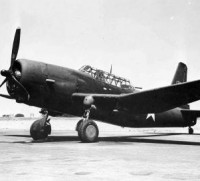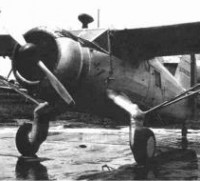BRAZILIAN AIR FORCE FAB * - BRAZILIAN AIR FORCE
33)B-17 AT BRAZILIAN AIR FORCE
The four-engine Boeing B-17 was one of the most important military aircraft of the 20th century, actively participating in World War II. Although it was designed well before the war, and flown for the first time on July 28, 1935, it was still considered very current in 1941. It was the most effective American bombers during the conflict, having launched more than a third (640,000 tons) Of the 1.5 million tons of US bombs launched in Europe and the Pacific by the end of the war in 1945.
However, with the end of the War, thousands of B-17s, remaining from the 12,731 manufactured copies, were deactivated. Since they were of little use to civilian operators, they were cut by thousands and turned into scrap. It could be said that, as a strategic bomber, his mission ended in 1945. But the B-17 was much more than just a bomber. Many of these aircraft were manufactured, or converted, into reconnaissance aircraft, aerial photogrammetry, cargo, and search and rescue. These versions had a considerable survival as military aircraft after World War II, especially the search and rescue versions (B-17H, later renamed SB-17) as we will see below.
In 1944, during the War, the Chicago Convention was held, the most important civil aviation convention ever held. It brought together 52 countries, including Brazil, and laid the foundations for civil aviation reordering around the world. As a result of the Chicago Convention, in 1947 the International Civil Aviation Organization (ICAO) was established, the most important civil aviation organization in the world.
The Chicago Convention established a number of responsibilities for signatory countries to ensure the safety and efficiency of civil aviation operations, including the obligation of each country to maintain long-range rescue, search and reconnaissance units within its area of responsibility.
Under the terms of the Convention, Brazil would have to provide support and protection to emergency aircraft flying over its territory and the Atlantic Ocean to and from South America.
This created a problem for the Brazilian Air Force. There were no airplanes, air units, military doctrine, experience or training for this task. Any aircraft that had difficulties, or if it acted on the Atlantic Ocean, for example, would depend entirely on the Brazilian Navy's ships for its rescue, or even on private vessels or aircraft.
FAB then began a process of adaptation, creating a search and rescue unit in Belém, using a single Consolidated PBYCatalina aircraft (FAB 6516). At the end of 1950, the FAB Aeronautical Search and Salvage Service was created, linked to the Air Route Directorate of the Ministry of Aeronautics. One of the major problems encountered was the lack of equipment for such a mission, especially those of great scope. In 1950, the Brazilian Government requested assistance from the USAF, attempting to purchase Boeing SB-17 specialized aircraft, so that it could meet ICAO requirements.
The USAF agreed to cede six such aircraft, with the first five arriving in Brazil in April 1951 at Galeão Air Base in Rio de Janeiro. They integrated the CTQ Training Center, (Four Engine Training Center), a temporary unit created on January 24 of the same year, with the exclusive task of forming an initial crew of crew and ground personnel for the operation of the B-17s.
Only two months later, in June 1951, the SB-17, here designated simply as B-17, were transferred, together with the CTQ, to Recife Air Base, in Pernambuco, where they would be dedicated to the training of search missions And long-range rescue, as well as aerial photogrammetry missions. During the CTQ phase, the aircraft were operated by US instructors, assigned by the USAF, and their paint schemes were basically the same as the USAF, except for the two-strip painted steering wheel, one green and the other yellow. In fact, the aircraft had not yet been officially incorporated into the FAB, which would occur only in December 1953.
During the CTQ phase, the first Brazilian B-17 crash occurred: on July 23, 1952, a CTQ B-17 (still registered as USAF 44-8557) equipped with a boat and piloted by a USAF officer, Made a demonstration of launching the boat on the sea, when it collided with a North American T-6, (the FAB 1555) flying in formation with the four-engine to make photographic coverage of the mission. Both aircraft fell into the sea, with no survivors. On September 1, 1953, the CTQ made the first ocean crossing of a Brazilian military aircraft, when one of the B-17s took off from Recife, landed in Dakar, Senegal, and returned to Recife, thus demonstrating for the first time the Brazil's ability to comply with the provisions of the Chicago Search and rescue services.
The CTQ was extinguished on October 15, 1953, and was replaced by the 1st Squadron of the 6th Aviation Group (1st / 6th GAV), still based in Recife. In December of the same year, the aircraft finally entered the collection of the FAB, being loaded with the registrations FAB 5400 the FAB 5404. The airplane lost in 1952 never received any designation in the FAB.
The peak of FAB's B-17 operations occurred in 1957, with a total of 5,800 hours flown. In March of that year, the FAB used the B-17 to support the Suez Battalion, a Brazilian unit serving the UN in the Gaza Strip, in the mission to pacify the region shortly after the Suez Crisis, triggered by the nationalization of the Suez by President Gamal Abdel Nasser of Egypt in 1956. B-17s flew 24 missions to the Middle East until 1960, taking 50 tons of supplies and mail by 1960 for a total of 2,071 flight hours.
The B-17s were replaced by the Lockheed RC-130E Hercules. The 2nd / 6th GAV (Aviation Group) was deactivated and its personnel and equipment were transferred to the 2nd ETA - Air Transport Squadron. The 1º / 6º GAV operates until today with the RC-130, in the same original mission of the old B-17, that provided relevant services in the FAB.
By Jonas Liasch

This B-17 H was beautifully restored and is in display at the entrance of Air Force Base at Recife. . Twelve B-17 were used by Brazilian Air Force in search and rescue missions and also used to transport Brazilian Army contingents for Egypt during the Suez crisis following its annexation by President Gamal Abdel Nasser in 1957.
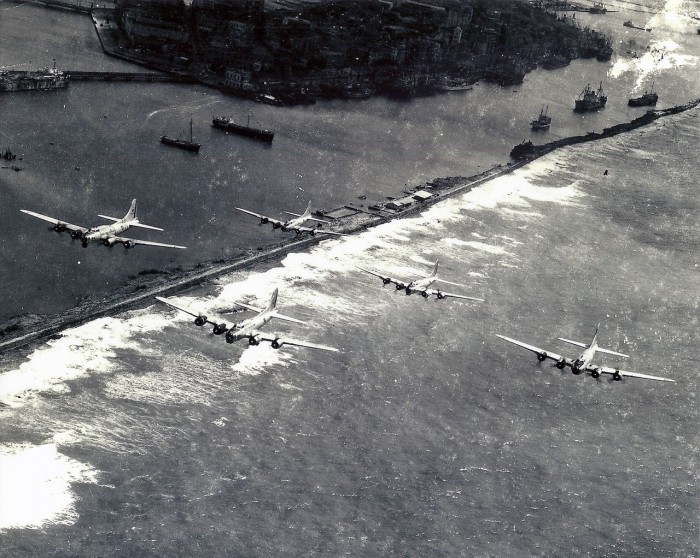
Above, five B-17 are seen in formation at low altitude over Recife during one training mission.
FOLLOWING PAGES ON THE SAME ARTICLE


